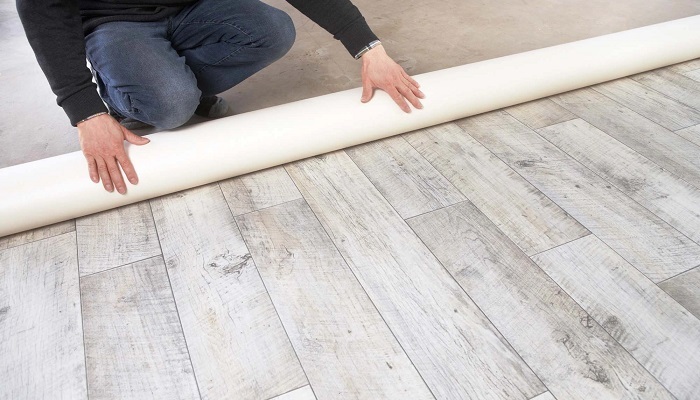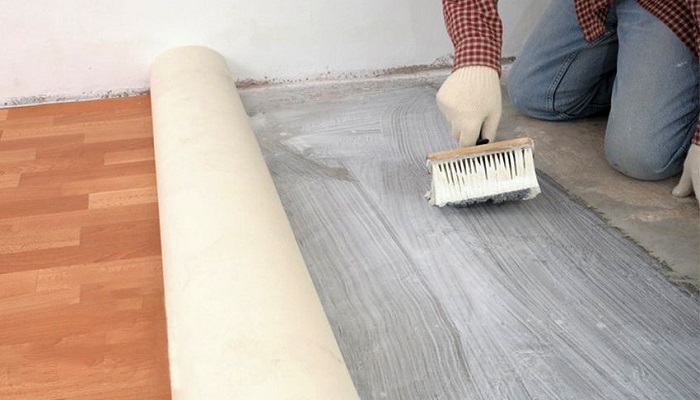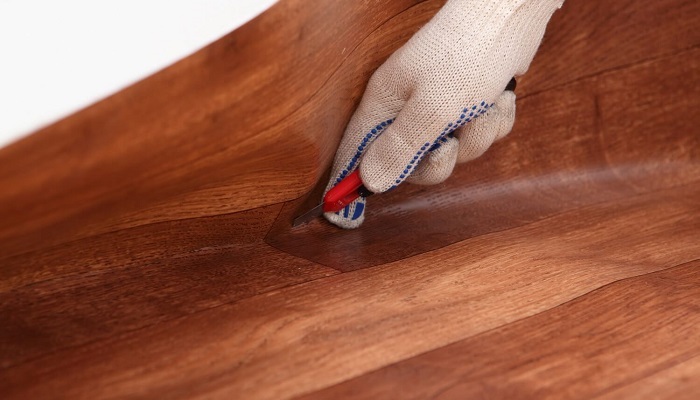Linoleum is a term that originally referred to a natural material made from linseed oil, pine rosin, and other organic materials. It is now used both as a general term for the original material and for a variety of modern substitutes made from vinyl plastic. These floorings, widely used due to their affordability, waterproofing and durability, usually installed by fixing over an existing floor or underlay with strong glue.
On what basis can linoleum be laid
Installing linoleum is an easy and popular way to update a floor in a room. The material is a strong and durable coating that can be laid on various types of base. For those who do not know how to lay linoleum, this article shows all the intricacies of the process.
Concrete and wood floor
Concrete flooring is one of the most common substrates for laying linoleum. Before laying material on a concrete floor, make sure that the floor surface is clean, dry and level. If there are irregularities or cracks in the concrete, they should be filled with a leveling compound or a special repair compound for concrete.
The floor under the linoleum can be wooden. It is also important that it be even and without visible damage. If there are potholes or bulges, they can be smoothed out by sanding or using plywood.

Is it possible to put new linoleum on the old coating
The possibility of laying new material on the old floor depends on the condition of the old floor and its adhesion to the substrate. If the old material has a flat surface, no delaminations or bulges, and is firmly attached to the base, then in most cases can be laid new linoleum over it. However, it must be taken into account that laying on an old floor raises the level of the surface, which may require appropriate adjustment of the height of doorways or other elements of the room.
When laying new linoleum over old flooring, it is important to make sure that the old material is not damaged, cracked or torn. If the old coating is in poor condition, it must first be removed.
Does it need to be glued?
When laying linoleum, gluing is often required. This provides a more secure and durable attachment to the base, prevents slipping and reduces the risk of air bubbles or lifting of the edges of the coating.
However, not all types of linoleum require gluing. Some types are self-adhesive coatings that have a layer of adhesive on their reverse side. In this case, it is necessary to remove the protective film from the back and carefully place it on the prepared surface.
If linoleum is not self-adhesive, then special adhesives are used to fix it, which are sold in hardware stores. The adhesive is selected in accordance with the type of coating and manufacturer's recommendations.
What to glue
When laying linoleum, various materials and methods can be used to glue it.

Fixation
Fixing is a method in which linoleum is fixed to the base without the use of glue. This method is suitable for self-adhesive materials or where a full bond is not required. Instead of glue, you can use double-sided tape or double-sided adhesive tape, which firmly connect the material to the surface.
Glue
For gluing linoleum to the base, special adhesives are often used. These solutions are usually designed specifically for a particular type of coating and have high adhesion and elasticity. They provide a strong attachment of the coating to the base, help prevent it from shifting or peeling over time. Adhesive is selected depending on the type of material. You can read about how to glue linoleum on the product label.
How to glue joints
For gluing joints, glue for linoleum or special glue for joints is usually used. This allows you to ensure a tight connection between the parts of the material so that the joint is invisible and durable. Seam adhesive is usually applied to the edges before they are joined, after which the edges are gently pressed together.
How to lay with your own hands
If you do not know how to lay linoleum, then do not worry. This is a fairly simple task that can be do it yourself.

Here's how to lay correctly:
- Prepare the base, make sure it is clean, dry and even.
- open linoleum and leave it for a few hours to acclimatize indoors.
- Cut if necessary material according to the size of the room with a margin for errors.
- Apply glue to the base using a notched trowel, spread the adhesive evenly over the surface.
- Lay linoleum carefully on the base, observing the necessary alignment.
- Walk on the surface material with a roller or wooden spatula to make sure it is well adhered and there are no air bubbles.
- If necessary cut off the excess edge of the linoleum using a sharp knife or special trimming tools.
Surface preparation
Before laying linoleum, it is necessary to remove all furniture, baseboards, household appliances and doors. You will need a hammer or screwdriver to remove the skirting boards, and a screwdriver to remove the doors. Do not try to work around doors when laying linoleum.
The next step is to prepare the surface:
- Make sure that floor surface is level, clean and dry. Remove any bumps, protruding nails or chips.
- If there are cracks on the floor or irregularities, fill them with a mixture or a special repair compound and then level the surface.
- If necessary sand the wood floor or use plywood to level the surface.
It usually takes 24 to 48 hours for linoleum to acclimatize at home. Since the material may expand and contract slightly, it is important to allow it to settle a little before laying. It is also important to leave a margin of 1 cm on each side to allow for expansion and contraction.
How to calculate how much linoleum is needed for a room
To calculate the number of linoleum segments needed for a room, follow these steps:
- Measure the width and length room with a measuring tape. Write down these values.
- Multiply the width by the lengthto get the area of the room in square meters.
- If there are ledges in the room or irregular shapes, measure them separately and add the resulting area to the total area of the room.
- Please note that linoleum usually sold in rolls of a certain width, such as 2 or 4 meters. Check the width of the material you plan to purchase.
- Divide the total area rooms the width of linoleum. This will give you the number of running meters needed.
- Consider margin. It is recommended to purchase a little more linoleum than is required by the calculations in order to be able to cut it to size and allow for possible laying errors.
- note that When buying linoleum, it is important to consider its texture in order to properly position it when laying and get a solid pattern.

Required Tools
For laying linoleum you will need the following tools:
- sharp or linear knife - for trimming and creating precise cuts;
- ruler or measuring tape - to measure the size of the room and material;
- glue or double-sided adhesive tape - for gluing the material to the base;
- notched trowel - for uniform application of glue to the surface;
- roller or wooden spatula - for compressing and compacting linoleum after laying;
- marker or pencil - for marking and indicating dimensions before cutting.
How to crop
Trimming linoleum is an important step when laying, as it allows you to precisely fit it to the dimensions of the room. Here's how to do it:
- Submit your material to the prepared surface of the room and leave some margin around the edges so that you can trim it accurately.
- With a marker or pencil mark on the linoleum the places where you want to trim.
- Using a sharp or linear knife, carefully follow the marks and cut the linoleum to the desired dimensions. Be careful and careful to get even and clear lines.
- If you have complex cutoutsFor example, under doorways or pipes, you can use a flexible knife or a hacksaw to make more precise and detailed cuts.
- Make sure that the cut edges of the linoleum fit snugly against the walls or other surfaces, and whether there are any gaps or free areas.
When trimming, always work slowly and carefully to avoid injury and achieve a professional result.

Glue to the base
gluing linoleum to the base helps to ensure it is firmly attached and prevents shifting or peeling. Here's how it's done:
- Make sure that the subfloor is clean, dry and level.
- If you are using glue, follow the manufacturer's instructions to properly prepare and apply the adhesive to the substrate. Use a notched trowel to spread the adhesive evenly over the surface.
- If you have self-adhesive linoleum, remove the protective film from the back and carefully place it on the base. Make sure that the coating adheres tightly to the surface and does not form air bubbles.
- When laying linoleum in large roomsyou may have to glue it in parts. In such a case, apply adhesive to the base in a certain area, and then lay the material on that area. Repeat this process as you gradually move around the room.
- Walk on the laid linoleum with a roller or wooden spatulas to ensure good adhesion between the coating and the substrate. This will help eliminate any air bubbles or wrinkles. Sealant must be applied between the seams to prevent peeling or possible water damage. Sealant will help give the floor a beautiful glossy sheen.
- If there is an extra piece, trim it with a sharp knife or special trimming tools.
Once the pieces have been joined together, do not allow the floor to be moved all day long so that the flooring adhesive can adhere to the material. After a day, you can begin to replace household appliances, doors, baseboards and furniture that you took out of the room.
Seam processing
When laying, seams may appear between the individual parts of the coating. For processing seams, you can use improvised materials: glue for joints or special tapes.

For this:
- If you have joint glue, apply it to the edges of the linoleum before joining them. A small amount of glue should be enough to ensure a strong and secure connection.
- When joining edges gently press them together to create a tight connection. Make sure the seams are even and there are no bumps.
- If you are using special seam tapes, place the tape along the seam and gently press it against the linoleum to ensure a secure connection.
- Seam processing will help create a smooth and uniform surface, as well as prevent the penetration of dirt or moisture into the joints.
Caulking may be required in some places. Pay attention to baseboards, toilets and other places near plumbing fixtures. Latex-based or latex-based acrylic putty is best suited for treating such areas.
Conclusion
Laying linoleum requires patience and a little planning. TThis floor is worth the effort, but it's also a great choice because of its durability and ability to enhance a space with little work.
Many people think that linoleum is the same as vinyl flooring, but there are a few distinct differences. Linoleum is waterproof while vinyl floors are waterproof. Another difference is that the material is made from linseed oil, pine resin and wood dust and has a jute backing, while vinyl flooring is made from synthetic materials.


